In this article, I take a look at why I think are the 5 best educational board games for teens available on the market in 2023.
Having a great time with board games is all fun and good, but what if you could learn something on top of that? Or if you could get your kids to play and they would learn about a subject without even realizing it? Sounds a lot better than memorizing science or history books, doesn’t it?
Table of Contents
To quickly jump to different parts of the article, click on one of the links below:
- Cytosis: A Cell Biology Game
- Wingspan
- Evolution: Climate
- 1775: Rebellion
- Freedom: Underground Railroad
- Conclusion (with my personal recommendation)
Criteria for Best Educational Board Games For Teens in 2023
Making this list, I followed certain guidelines:
- I wanted to present games that offer an educational theme and engaging gameplay with plenty of options for players. That pretty much leaves out all the trivia games. Yes, you can learn from them, but from a gamer’s perspective, they are nothing more than a bunch of loosely connected questions, rather than a board game.
- Games on the list are of medium complexity. That means anyone with a bit of gaming experience can learn them easily, but they also sport decent strategic and tactical decision-making, pleasing more advanced players.
- This goes hand in hand with our title – for teens. Medium complexity is a level suitable for teenagers. It also means these games can be played by the whole family – together, gamers and non-gamers alike.
- There are quite a few science board games out there, that fail in the gameplay department. They may be educational, but they are not fun. So this is a big one: an interesting educational theme, combined with good game mechanics and fun gameplay.
Besides educating, board games have more positive effects on your life, than you imagined. Why is it good to play board games?
( I am a member of the Amazon Associates program. If you click on an affiliate link and then decide to buy something, I will earn a commission.)
Cytosis: A Cell Biology Game
Players: 2-5
Playing time: 60-90 minutes
Ages: 10+
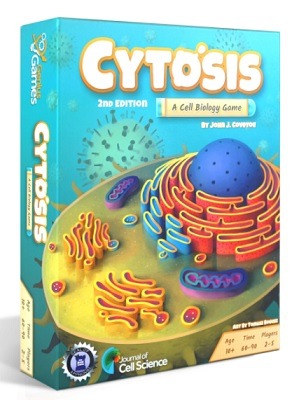
What can you learn in Cytosis?
I never really liked biology in high school, particularly biology on the cellular level. But if our teacher would bring this game to the class, maybe it would have changed my mind. Cytosis will teach you about cell biology, its components, and the processes in the cell.
How to play Cytosis?
By game mechanics, this is a light to medium weight worker-placement board game. It means you will learn it quickly, but it also has some depth to it. Or, if you played a similar game before (such as Viticulture), you will feel right at home.
The cell serves as your board and its various structures are places where you can place your workers to collect resources, purchase and collect cell component cards or take the first player marker.
Resources:
- The nucleus gives mRNA resources (black cubes).
- The plasma membrane gives Carbohydrates (green cubes) in exchange for ATP (money).
- Mitochondria give ATP.
- Smooth ER gives lipids (yellow cubes)
- Free Ribosome allows you to trade mRNA cubes into proteins (red cubes).
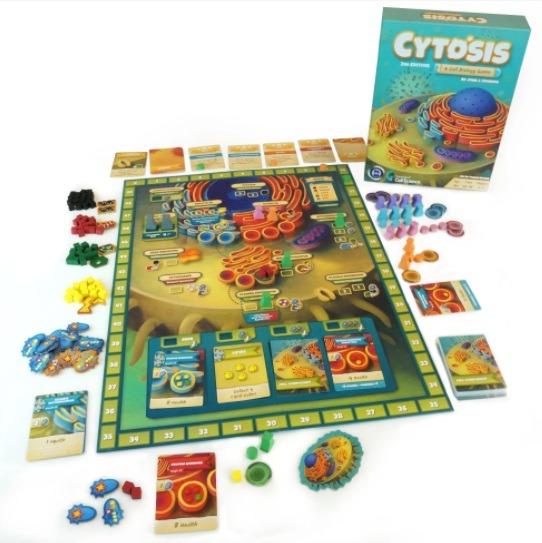
You can buy cell component cards at the bottom of the board in exchange for ATP. Then all you have to do is complete them (using resources) and you will receive health points (victory points). Completing them happens when placing workers on specific spots in Smooth ER, Rough ER, Golgi Apparatus, Plasma membrane, or Cytoplasm, depending on the card type.
To spice things up, there are goal cards that score extra points and event cards that act as special abilities, like boosting your resource income, or lowering ATP cost. And if that is not enough, just flip over the board and play with the virus expansion, which is also included.
At the end of the game, scores are added together and the player with the most of them wins the game.
Main strengths
- Accurate cell display. If it’s good enough for a biology professor, it’s good enough for me.
- The theme works well together with game mechanics.
Main weaknesses
- If you’re looking strictly for a worker placement game, there are better alternatives out there.
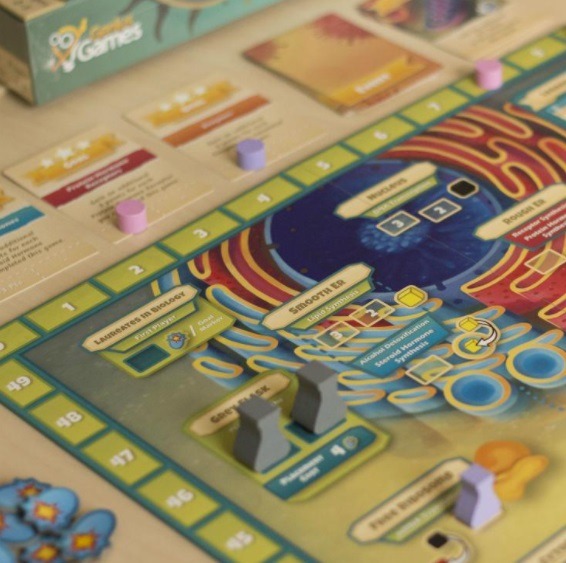
Should you buy Cytosis?
Cytosis delivers what it promises on the box – it will teach you about the cell and the processes in it. It’s a perfect gift for a young, aspiring biologist.
If you’re looking into this as a gamer: get it, if you like the theme. Don’t get it for the gameplay. I’m not saying it’s a bad game, I’m saying there are better strategy games alternatives out there.
Wingspan
Players: 1-4
Playing time: 40-70 minutes
Ages: 10+
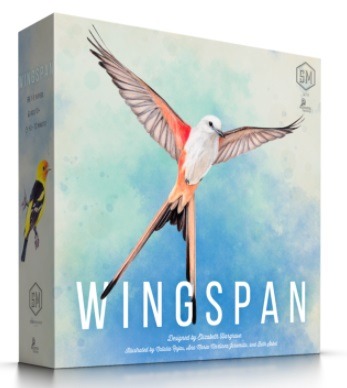
What can Wingspan teach?
You will learn about birds. Their names, appearances, sizes, habitats, and interesting facts. 170 bird cards are included. I had no idea there even were that many sorts of birds (sorry for my ignorance), let alone their characteristics – and that is without the expansions.
How to play Wingspan?
Wingspan is a card-driven engine-building game. The goal is to attract birds to your habitats (your player board): forest, grasslands, and wetlands. Some birds only nest in certain habitats, while others are more flexible.
The course of play is very simple and accessible. The game is played over four rounds and each lasts between five and eight turns. On his turn, a player has four options:
- Play a bird card from his hand, pay its cost, and place it in a habitat on his board.
- Gain food and activate powers on his birds in the forest.
- Lay eggs and activate powers on his grassland birds.
- Draw cards and activate powers on his wetland birds.
Food is a resource needed to place birds on the board and there are several types of food: worms, seeds, fish, fruit, and rodents.
Eggs are used to place birds beyond the first slot, while cards give you more birds to place.
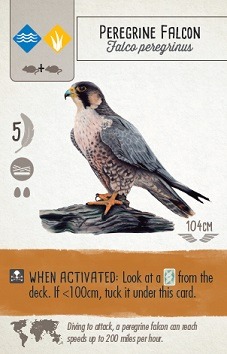
Building your engine and combining different bird powers
Where it gets a bit more complicated and the game offers some tactical depth, is combining the placement of birds and their powers. Three categories of bird powers exist:
- Powers that activate immediately when using a corresponding habitat, like gaining a type of food or tucking another bird card under it (creating a flock).
- Powers that activate between turns, usually triggered by another player’s actions.
- One-time powers that only activate when you place the bird.
On top of that, there are end-of-round special goals that are randomly selected. You’ve got to balance between achieving these mid-goals and optimizing your engine for maximum end-game score.
End-game scoring takes into account the number of birds on the mat, bonus cards, bonus points for end-of-round goals, eggs, food, and tucked cards under birds. Basically, everything you did will bring you points.
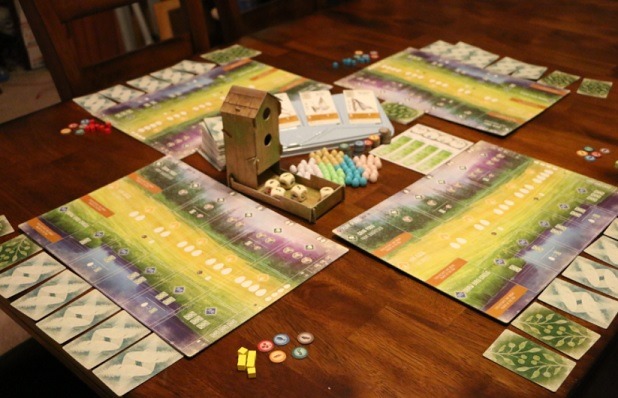
Main strengths
- Easy to learn
- Brilliant presentation
Main weaknesses
- Birds are just a theme over a game, not a full simulation of birdlife.
- The outcome somewhat depends on the cards drawn during the game.
Should you buy it?
There was a lot of hype around Wingspan in 2019 and many hardcore players were disappointed by the simple game mechanics. But that is not Wingspan’s fault, but rather of his predecessors: it is published by Stonemaier Games, previously known for highly-rated titles such as Scythe or Viticulture. These games created too high expectations in the community.
Why Is Wingspan So Popular? – 5 Reasons
But if you take Wingspan for what it is – a gateway engine-building board game with high-quality production standards, it delivers. And you can learn about birds with it.
Evolution: Climate
Players: 2-6
Playing time: 60 minutes
Ages: 10+
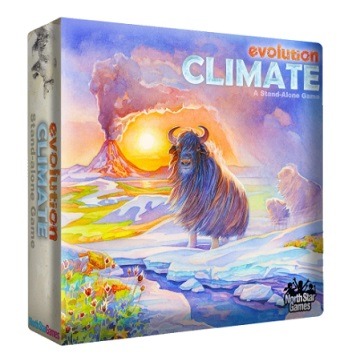
What can you learn?
You will learn what traits species need to survive, how they evolve according to available food, predators, and climate change, and how all of these factors together form a natural selection, deciding whether a species will thrive or become extinct.
How does it work?
Evolution: Climate is an engine-building card game, where you breed your own species of animals. The game is pretty simple to play and set up. Each player begins the round with a certain number of trait cards. He must then use these cards to add food to the food pool, create new species, or enhance his current species.
Contributing food to the food pool is a very important phase. Players will decide which card to discard, as there are different food values on them. This food is later used for feeding herbivores. It will be in the best interest of some players to have a lot of food available, while some will prefer to put in as little as they can.
Next, it’s time to play your cards. There are 4 ways to enhance your species:
- Discard a trait card to add new species to your portfolio.
- Discard a trait card to add to species size. Size matters when predators are around, as they can only hunt species smaller than themselves. It also helps with some climates (and makes it worse in others).
- Discard a card to add population to species. Having more population means you can eat more food (get more points) and survive easier, but it also means the population will be harder to feed.
- Add a trait to species. You can use the trait card directly for enhancing your species’ special ability. Each species can have a maximum of four traits.
For example, horns and herding help with defending against predators. Scavenge, forage, tall neck, and cooperation help with gathering food. And gigantism, burrowing, heavy fur, nocturnal, hibernation, mud wallowing, etc. helps you counter environmental threats.
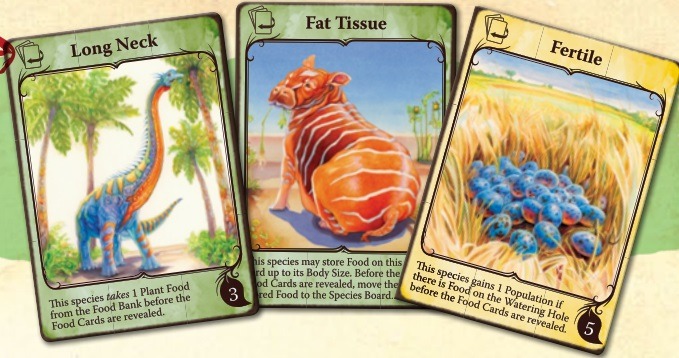
Predators emerge if there are enough herbivores around for food
Sooner or later, one of the players will assign a carnivore trait to a species. This means it cannot feed on the food pool but must eat other animals (reducing their population) to survive. Or you can assign intelligence, which helps with finding extra food and negating prey traits. Or even both, to create a deadly killer.
You can even sustain a herbivore species with a large population and a carnivore species, that specializes in feeding on that herbivore, making you very independent from the food pool or other players. But it only takes a small climate change or a second predator from another player to tip the balance the wrong way …
Feeding
Feeding happens after the players use their cards. This is when they assign food from the pool to their species and when carnivores hunt. If there is not enough food to feed everyone, the population of a starving species is decreased. The population also decreases with hunting. In the worst-case scenario, species can become extinct.
Food is important because it counts as victory points. So, the more food you gather and the less food other players gather, the higher your chances of winning are. Species traits also count as victory points at the end of the game, so having a lot of species with a lot of traits is a good thing (as long as you can feed them).
When contributing to the food pool, players also contribute to climate change icons. These can sway the climate in two directions (hotter or colder), affecting available food and survival. Additionally, special events, such as heat waves, volcanic eruptions, or glacial thaws, further complicate matters.
It’s all in the balance
Evolution: Climate is a game of balance between available food, climate, and species adapting to the environment and how to best defend or attack other creatures.
In a lush, food-rich climate, you may develop large herbivores with tall necks, living in herds, while other players may develop intelligent species hunting them in packs. Then, as climate changes to hot, small nocturnal species will thrive, while in cold, fur may help you survive.
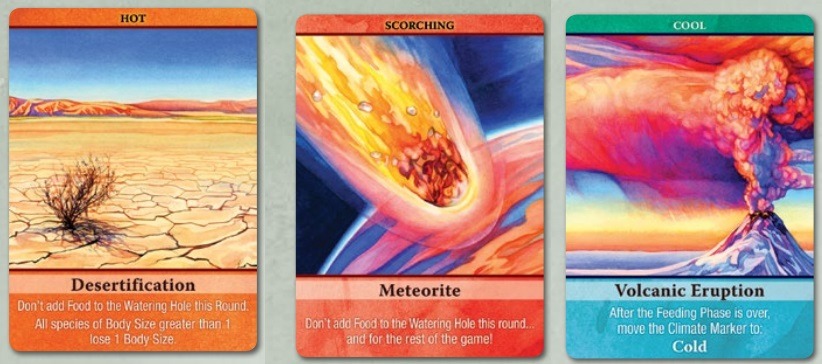
Main strengths
- A realistic demonstration of how species adapt and evolve to climate, environment, food, and predators.
- Colorful art.
- Great educational value and is easy to learn.
Main weaknesses
- It isn’t mandatory in schools.
Should you buy Evolution: Climate?
Learning about evolution has never been so fun, and if I would want to teach my kids about it, Evolution: Climate would be my first choice. If every school used this, I’m sure there would be no skepticism about Darwinism anymore.
But there is more – in 2020 Evolution: Oceans was released, focusing on, you guessed it, species in the oceans. If you like the Evolution series, keep an eye out for that.
1775: Rebellion
Players: 2-4
Playing time: 60-120 minutes
Ages: 10+
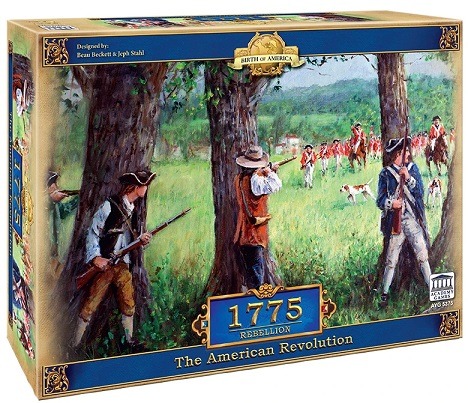
Can you learn history with 1775: Rebellion?
If you take a look at the year in the title, you’ll have a pretty good idea of what this game is about. It’s about the War for America’s independence. The game will teach you about historical events that lead to the American Revolution, which sides were involved, and how it eventually ended. Although the game outcome may differ from the actual one.
But most importantly, it will raise your interest in history and after playing this game, you will find yourself browsing Wikipedia, trying to learn more.
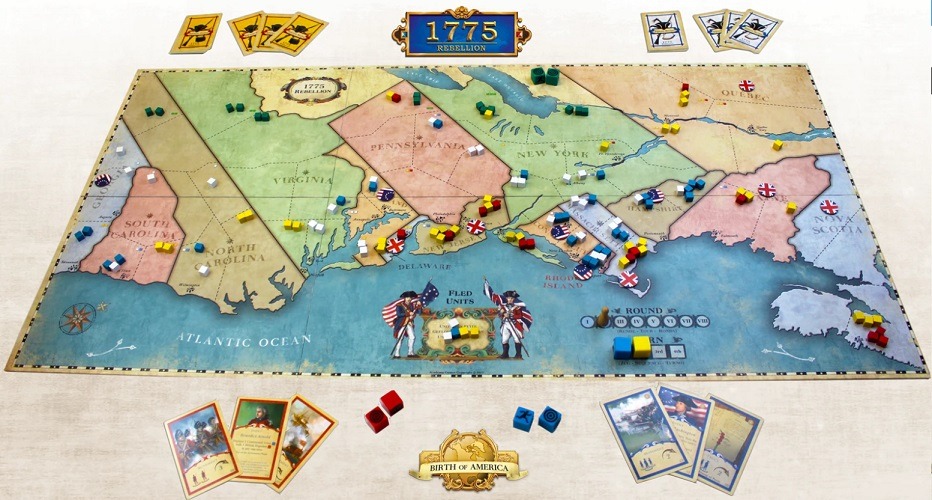
How does it work?
1775: Rebellion is a war game, with a lot of similarities to Risk. The map represents the original 13 colonies plus Maine, Nova Scotia, and Quebec. Each colony is divided into smaller territories.
There are 2 sides with 2 factions each + an ally faction. Continental Army and American Militia can get help from Allied French, while the other side, British Regulars, and Loyalist Militia can be helped by Allied Hessians. Allies can be brought into the game with event cards.
There is also a seventh faction, the Natives. They can join either side and even switch sides during the game.
Phases
The game is played over eight rounds, and each round has several phases:
- reinforcements,
- movement,
- battle and
- draw cards.
Combat is pretty straightforward and the outcome is decided by dice. Dice can result in:
- hit (enemy must remove one of his units),
- flee (your unit must flee to the fled unit box, from where they can later return as reinforcements) or
- command decision (you decide whether your unit stays or retreats to a nearby territory).
Custom dice
Dice are specific for each faction – Brits have higher hit possibilities, Militia is more likely to flee, etc. This adds more room for tactical maneuvers and playing to your faction’s strengths is a must. The ability to move your allies together with your troops adds to this and strategic planning is rewarded with greater combat odds.
Victory conditions are different for each side and are based on historical events. The game ends when one of the sides meets their victory conditions, or both sides play the truce cards, or after eight rounds.
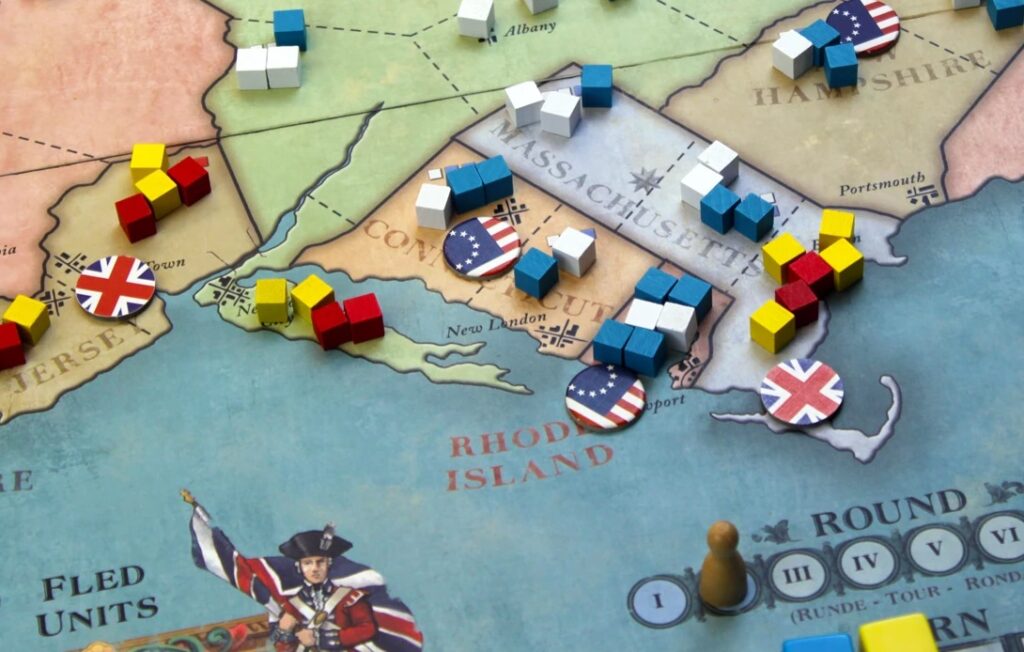
Main strengths
- Simple, easy-to-learn game mechanics, but they still offer a challenge.
- Historically accurate setting and events.
- In a 4-player game, players are split into 2 vs 2, which guarantees intense coop and competitive gameplay.
Main weaknesses
- Units are only represented by cubes. There are no miniatures (this might be a positive for some people).
- If you played something more complex before (i.e. War of the Ring), this will feel too simple.
Should you buy it?
I would suggest this game to players, who are looking beyond Risk. This is also a great gift for an elementary school kid interested in America’s history.
Rebellion is part of the Birth of America series, which contains three games and one expansion, but Rebellion covers the most interesting topic, in my opinion.
Freedom: Underground Railroad
Players: 1-4
Playing time: 60-120 minutes
Ages: 12+
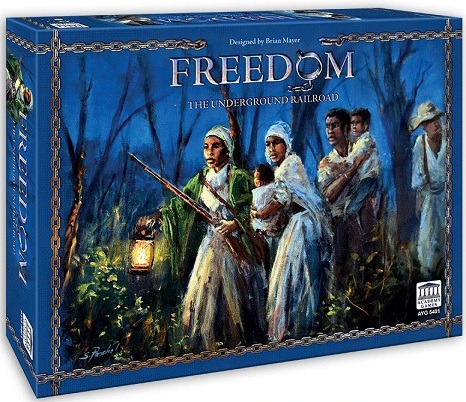
What can you learn in Freedom: The Underground Railroad?
When Rebellion ends, Freedom picks up. It revolves around the Abolitionist movement working towards ending slavery in the United States. Players will learn about slavery, events that lead to the Abolitionist movement, and events that ended slavery and started the Civil War.
How does it work?
Freedom is a cooperative game. Players (the game works very well in solo mode too) play as members of the abolitionist movement. They must achieve two victory conditions:
- Raise support for the Abolitionist movement
- Help slaves from the South escape into Canada.
The first condition can be achieved by buying enough Support tokens, while the second is achieved by buying Conductor tokens, Abolitionist cards, and using the player’s role abilities. These allow you to move slaves on the map.
Abolitionist cards are made of historical events and persons that marked the era and the movement. They are special abilities, often stronger than tokens, but be careful, as there are negative events in the deck as well.
From South to Canada
The map is limited to the eastern part of North America and is roughly split into three main areas: South, North, and Canada. There are numerous paths from South to Canada and you will choose freely which ones to use to smuggle slaves.
Some routes are more dangerous, but give you more money for the movement, while safer give less. How dangerous the path is, is depicted by slave catcher tokens, who move on the map.
Their possible paths are drawn on the map, but you never know which way they will go, until you roll the slave catcher die. If the slave is caught, he goes to the slave market and if he can’t be delivered back to the plantation, he is lost. Lose enough slaves and you lose the game.
The trick is to spend your resources wisely – try to strike a balance between growing support for the Abolitionist movement (so that slavery can be abolished at the end), while trying to save as many slaves in the process – taking risks while avoiding slave catchers. You might be faced with tough moral decisions – let one of the slaves be caught for three others to come through?
It’s a whole different dilemma when you know the theme has been designed around real people’s fates, not mythical creatures.
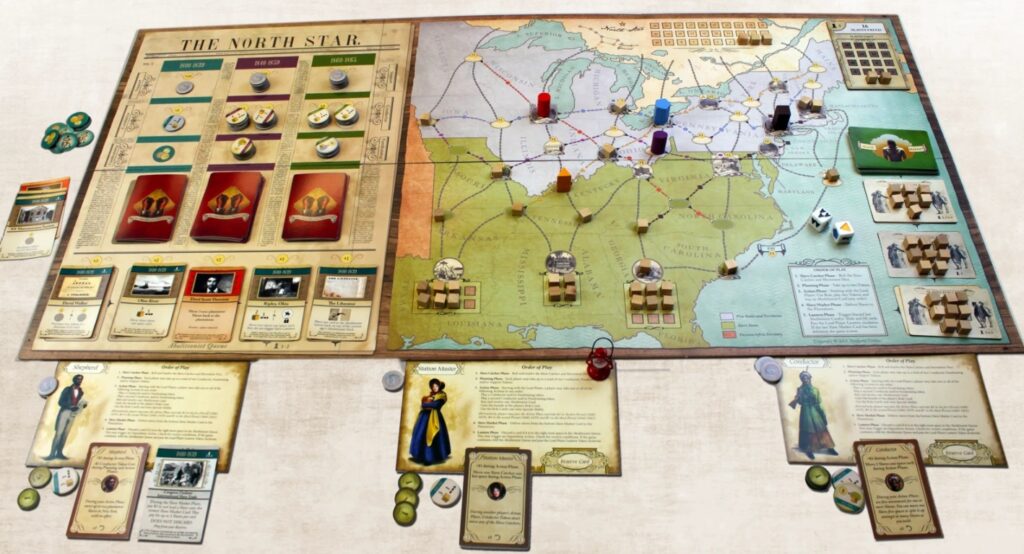
Main strengths
- Very powerful theme.
- Plays great in solo and coop.
- Easy to learn.
Main weaknesses
- Slaves are depicted only by cubes. The message would be even stronger if they would be given more personalization.
Should you buy Freedom: The Underground Railroad?
Anyone interested in this dark period of American history will find a lot of educational value in this game. I think that Freedom: Underground Railroad, should be on every history-loving gamer’s shelf.
It provides a better reflection on the subject than a lot of history books do. On top of that, it’s also a very good game.
Conclusion
I think I’ve given you plenty of material to think about: biology, birds, evolution, and American history. They may not replace books, but these board games will give you a nice background on the subjects and you can learn a lot from them. They are a great addition to both school kids’ and gamers’ collections.
My favorite from the list is Evolution: Climate, because of the intricate balance between natural resources, climate, and other animals. It is one of the best displays of evolution for the general audience I have ever seen.
I also love Freedom for its historical accuracy and strong theme and Wingspan, because it’s one of the top family board games.
Do you agree with my list or do you have any favorite educational board games of your own? Leave a comment below.
Further reading:


Hello. Thanks a lot for such an amazing article about this educational games.
You really got me. My boy is in love with this kind of games and i m very happy because this offer him a good education and improves his imagination and creativity. For this Christmas holidays i want to make him a gift. My favorite is Rebellion 1775 because of this historical theme about wars. I can t wait to discover together this world.
If you don’t mind, i will share this on my social media accounts. Thanks again and wish you all the best.
I don’t mind, share all you want. 🙂
Thank you for your post. It is useful information for me. I have not find Christmas gift for grandson, who is in 10th grade and wants to be a biology professor. The other day, we discussed some biology topics and I couldn’t answer some of his biology questions. He is very interested in biology.
Cytosis: A Cell Biology Game is a perfect gift for my grandson. I am going to purchase this for him and I myself would like to play this biology game with him. Cytosis is about cell biology, it’s components and the processes in the cell, which is the interests of my grandson.
It is kind of you sharing this useful information with us.
Great! I’m sure your grandson will enjoy and learn from Cytosis. 🙂
This is awesome! I am a history and geography teacher and it would be fun to use these board games in class. I will recommend the cytosis, evolution, and the wingspan game to our biology teacher. I think she’ll love the suggestion! I especially like the evolution game. That one has a lot of activities that will help teens learn.
The historical games look great too. Do you know if there are more historical games, like the French Revolution, Napoleon, WW1 and/or 2? I would be very interested in using them for my classes.
There are 2 games, I’d like to suggest.
Memoir ’44, a historical board game, based on WWII battles like: Omaha Beach, Pegasus, Bridge, Ardennes etc. It’s a wargame – it simulates battles between two side. It can be played by two player or by teams. I’m sure your students will remember the details of those battles with greater ease after playing this. Several expansions exist, covering other fronts of the war.
Second game I recommend is The Grizzled, a cooperative game about survival in the trenches of the Western front during WWI. It’s one of the best ways to experience the hell of trench warfare.
Hi Vasilij! Oh, this is gold. I genuinely like them all. It’s so much fun to get all the family around a board game. And if we and our teens can learn useful stuff while playing, it’s a huge bonus. I particularly liked Cytosis: A Cell Biology Game. I’ll purchase it for this winter. Thanks for these five great suggestions.
Thanks for the comment. I’m glad you found something for yourself.